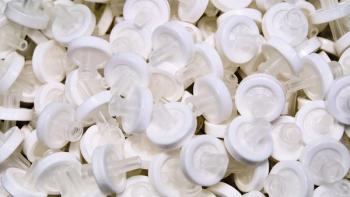
- BioPharm International, July 2022 Issue
- Volume 35
- Issue 7
- Pages: 25–28
Quality by Design for Affinity Chromatography
Enriching process understanding enables robust process controls.
Application of a quality-by-design (QbD) approach to process development is not limited to upstream and downstream operations. It should, in fact, be implemented for all aspects of drug development, including the design, development, and production of key raw materials. As such, QbD methodology has a role to play during the development of affinity chromatography processes and even prior to that in the development of the resins used in these processes. In both cases, a QbD approach can help minimize variability and lead to the development of robust manufacturing processes that consistently yield high-quality product.
The goal of a risk-based QbD approach is to identify the factors that will have the greatest impact on process performance (i.e., critical process parameters [CPPs] and critical material attributes [CMAs]) and how they may impact the quality of the drug substance. For affinity chromatography, in addition to resin attributes, the load ratio, pH, and conductivity are some of the factors to be considered.
It starts with the resin
One issue facing developers of affinity chromatography processes has in the past been measurable batch-to-batch variability in the affinity resins used. To overcome this problem, resin suppliers need to fully understand the relationships between resin manufacturing process parameters and the important resin characteristics that may affect resin performance, according to Gunnar Malmquist, a senior principal scientist with Cytiva.
That goal can be achieved, says Laurens Sierkstra, a business segment leader in Thermo Fisher Scientific’s BioProduction Group, with the use of a platform production technology. “Comprehensive platforms start with the identification and development of the affinity ligand and continue through all manufacturing steps required to produce the resin,” he notes. Without a platform, Sierkstra stresses that affinity ligands are then developed differently in different systems, which can affect the length of process development, compromise quality, and create inconsistency from lot to lot.
Applying a QbD approach is also highly effective in the development of affinity resins with minimal lot-to-lot variability. “The principles of QbD force an explicit focus on identifying the resin critical quality attributes [CQAs], which in this case are structural properties, and setting a control strategy that enforces process control,” Malmquist explains.
Cytiva has a long history of using the QbD framework for resin development, according to Malmquist, “allowing the development of a deeper understanding of structure-function relationships from resin design and connecting manufacturing process parameters to chromatographic performance, including robustness.”
All of Cytiva’s protein A resins since MabSelect have been developed using these principles, according to the company’s product manager for antibody capture, Josefin Bolik. Factors important for controlling physical/chemical properties in each manufacturing step are verified with design-of-experiment (DoE) studies. Verification, she observes, confirms the product will have design outputs that meet the product requirements, while validation confirms that the right product has been designed and that it will fulfill user needs.
Examples of affinity resins from Cytiva developed with this approach include MabSelect PrismA, which has improved alkaline stability and
binding capacity, and MabSelect VL, which has been designed specifically
for the purification of antibody variants and fragments.
Thermo Fisher applies a QbD approach to developing and optimizing its affinity chromatography resins, including the LambdaXP, CH1XL, FcXP, and KappaXP products. Its CaptureSelect technology, notes Sierkstra, incorporates high-throughput screening that enhances the performance of ligands (e.g., elution of the target molecule, stability under certain clean-in-place conditions, specificity of binding and binding kinetics, etc.). The designed ligands can then be manufactured, purified, and immobilized on a resin using the company’s platform. “By leveraging QbD in our technology and processes, the final product meets predefined performance and manufacturing criteria including minimal lot-to-lot variability,” he contends.
Protein A capture
The greatest challenges in developing robust, reproducible, and high-yielding affinity chromatography processes are business-related, believes Kristina Pleitt, senior manager of systems design engineering in the BioProduction Group of Thermo Fisher Scientific. “Pressure to decrease timelines often forces process developers to reduce development scope,” she says.
“Fortunately,” Pleitt adds, “deep experience with affinity chromatography processes enables manufacturers to save development time without sacrificing yield and robustness.” The most basic form of affinity chromatography is the capture step using Protein A (ProA) affinity resins. The inherent selectivity of the ProA ligand gives a more or less built-in robustness, reducing the likelihood of variability as long as column packing reproducibility and the alkaline cleaning process are under control, Malmquist comments.
The ProA step, in addition, has been widely implemented for monoclonal antibody (mAb) therapeutics for more than 20 years, leading to a wealth of knowledge that is available to aid the development of robust processes, agrees Bala Thangaraj, director of downstream process development at Catalent Biologics.
Problems such as low capacity; the need to elute the antibody using an acidic buffer, which affects product quality (increased aggregates); and the absence of caustic stability, which is needed for cleaning between cycles, all of which existed in the earlier days of ProA use, have since been largely addressed through ProA ligand engineering, Thangaraj comments.
As a result, Pleitt points out that instead of taking time to identify target operating conditions, developers can use their general operational knowledge and conduct experiments that focus on potential CPPs that will improve their understanding of the design space.
Even so, a QbD approach is still useful. “The early identification of CPPs and their proven acceptable ranges (PARs) can be instrumental to the development of a robust chromatography process in general,” insists Alex Boulbrima, a principal scientist at Charles River Laboratories.
Some challenges in mAb affinity chromatography process development do, in fact, remain. The aggregation or reduction of the di-sulfide bonds between the heavy and light chains are typical examples of CQAs that continue to be problematic, according to Boulbrima. “Their monitoring must be a priority, as is the establishment of robust PARs and normal operating ranges (NORs) for the chromatography step to mitigate those CQAs,” he notes.
The risk ranking of process parameters also becomes different when implementing continuous mAb capture processes, according to Malmquist, because it requires more thorough characterization work to establish process parameter ranges that enable robust performance at extended cycle numbers.
For separation of antibody variants in the ProA step, there can also be various challenges that require a different approach compared to a regular mAb capture step. “For instance,” observes Bolik, “a gradient elution combined with ‘narrow’ process parameter ranges for conductivity and load ratio may be required.”
Affinity chromatography of new modalities
Newer antibody-based biologics may also require different affinity solutions, such as ProA ligands engineered to bind to different regions of the biomolecule. Even though more complex biologics may require different affinity solutions, these solutions are also inherently robust, Bolik assures. She does point out that if the affinity step provides separation of product-related impurities (e.g., through avidity effects), stricter requirements for process parameters such as elution pH, etc., may be necessary. Alternatively, the separation of these species must be ensured in the subsequent polishing steps.
For some non-Fc-based modalities, notes Thangaraj, some conventional ProA affinity resins can bind to variable regions of the heavy chain (VH region), enabling capture of antibody fragments. “While this approach can suffer from low capacity, adjusting the salt concentration can act as a helpful tool to address this issue,” he says.
In other cases, such as to aid purification of multichain bispecifics, resins need to be generated with specially designed ProA ligands engineered out of the VH binding region. Such mAbs with silenced Fc-regions may, more specifically, require the use of affinity towards VH3 or other antibody domains, Bolik adds.
Entirely different affinity resins, such as Protein L (ProL), can also be used to capture antibody fragments. However, due to the instability of fragments in comparison to mAbs, the loading factor, elution buffer pH, and hold time must be extensively studied.
For more complex biomolecules such as viral vectors, antibody drug conjugates, etc., Boulbrima says the biggest challenge remains the establishment of a broad and performant package of analytics, which is needed for the identification of specific CQAs that in turn help establish the correct CPPs and PARs.
For all newer modalities, an added challenge may be that a suitable commercially available affinity resin does not exist. If that is the case, Pleitt believes that while sourcing a custom affinity resin can add significant time and cost, doing so may be a favorable option because having an affinity resin as part of the process can also be beneficial.
Many benefits of a QbD approach
The greatest benefit of employing a QbD approach for affinity chromatography process development is the creation of a robust process with a sound control strategy for relevant CPPs that impact quality, such as elution pH, linear velocity, and load ratio (loading capacity of the resin). That is important because, says Pleitt, affinity chromatography normally occurs towards the beginning of the purification process, and the outputs are inputs to the rest of the downstream unit operations, which means the process can ultimately impact product CQAs.
“Elucidation of the relationships between CPPs and CQAs leads to the definition of a robust control strategy for this step,” Thangaraj states. This relationship is well established for mAbs and Fc-based modalities, with loading factor and elution buffer pH (acidic) being the most common CPPs to affect CQAs and performance indicators, notably yield, according to Thangaraj. It is even more important for biologic drug substances for which traditional ProA capture steps are not applicable.
Affinity chromatography also benefits from the inherent robustness of the process, which helps deliver consistent unit operation outputs while allowing variability in process parameters and inputs, according to Pleitt. “The specificity, robustness, and available knowledge for many affinity resins are a great starting point for development and provide a solid foundation for building out process knowledge. Frequent use of affinity resins aids in selecting the most likely CPPs that should be the experimental focus. Streamlining the development and risk-based approach to experimentation helps accommodate the ever-present business pressures of time and cost, while maintaining compliance and ensuring sound knowledge of process performance,” she explains.
QbD, concludes Boulbrima, has helped greatly in justifying product specifications, process validation, and robustness. “Moreover,” he continues, “it has reinforced our knowledge with respect to process performance and the appropriate control strategies to be put in place.”
Resin considerations in process development
Application of a QbD approach to affinity chromatography development typically begins after resin selection has been made, generally due to the resource intensiveness and associated costs of QbD approaches, Thangaraj notes.
Even so, a QbD mindset should be applied at all stages of the development process, according to Pleitt. For instance, as discussed above, resin suppliers should apply QbD when designing resins and developing their own manufacturing processes. Of course, Malmquist observes, it also behooves drug developers to select resins that have good column packing properties and high alkaline stability to maximize the likelihood of a robust manufacturing process at scale.
Selection of the resin, says Boulbrima, is done based on performance studies, which he suggests might still qualify as a light QbD
early-identification activity. “Even during resin screening,” Pleitt adds, “an understanding of the desired performance and outputs is needed. While the overall process performance may be undefined, understanding the expectations for the unit operation from the start—clearance of various impurities, ability to accommodate variability in the feed stream, etc.—is important,” she contends.
More effective control strategies
A QbD approach involves leveraging development data to establish CPPs early in the development process, focusing on process characterization (PC) study parameters, identifying impacted CQAs, and minimizing rework, notes Marcia Kary, principal scientist, downstream process development with Catalent Biologics. “The PARs generated by the PC study give a more complete process understanding and ensure process control when later process changes or situations arise,” she says.
In addition, Malmquist believes a QbD approach allows developers of affinity chromatography processes to focus on the most important aspects of the step and pinpoint the CPPs that are important to control in order to ensure product quality.
Pleitt goes further, noting that ideally the increased process understanding gained by using a QbD approach should allow for more process flexibility and reduced emphasis on end-product testing. Today, she says, control strategies for biopharmaceutical production frequently involve tight constraints on process parameters and material attributes with extensive end-product testing.
“A QbD mindset enriches the process understanding and can help identify and characterize a wider design space. By linking parameter performance and material attributes to unit operation outputs, it helps process developers move away from the lowest level of control and makes it possible for them to focus on the inputs that truly impact the product,” Pleitt concludes.
About the author
Cynthia A. Challener, PhD, is a contributing editor to BioPharm International.
Article details
BioPharm International
Vol. 35, No. 7
July 2022
Pages: 25–28
Citation
When referring to this article, please cite it as C. Challener, “Quality by Design for Affinity Chromatography,” BioPharm International 35 (7) (2022).
Articles in this issue
over 3 years ago
Automating Biopharma Manufacturingover 3 years ago
Plant-based Expression Systems are Gaining Mainstream Advantageover 3 years ago
The Road Ahead for the Pharma Cold Chainover 3 years ago
Improved Formulations to Enable Stable Delivery of Biologicsover 3 years ago
FDA Advances Quality Initiatives to Combat Drug ShortagesNewsletter
Stay at the forefront of biopharmaceutical innovation—subscribe to BioPharm International for expert insights on drug development, manufacturing, compliance, and more.




